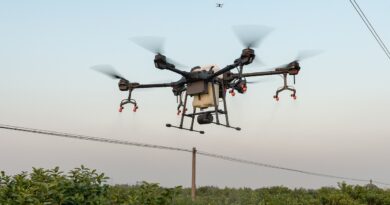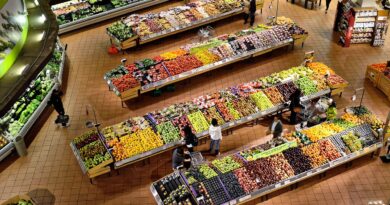Sustainable Agriculture through Robotics and Automation

INTRODUCTION
Green revolution in sustainable Agriculture has not been overlooked at a time when environmental issues are at the top of the agenda in international discussions. A high-tech, environmentally friendly industry has replaced the conventional image of farming. The use of robots and automation in agricultural processes is one of the elements driving this shift. In this article, we’ll discuss the vital role that automation and robotics play in sustainable farming, including organic and precision farming.
The Evolution of Farming:
Since the beginning, agriculture has advanced significantly. In the past, physical labor was largely utilized in agriculture, which was not only labor-intensive but frequently resulted in inefficient resource usage. The demand for more effective and sustainable farming techniques has become crucial as the world’s population keeps growing. Automation and robotics are here to fill those gaps.
The Changing Landscape of Agriculture:
Farming has always been a labor-intensive activity that relies significantly on human intervention and frequently leads to inefficiencies and resource waste. Traditional agricultural methods have a negative impact on soil quality, water pollution, and greenhouse gas emissions because they utilize too much water and chemicals. The agriculture sector has embraced technical advancements to address these issues, ushering in an era of clever, environmentally friendly farming.
- The Role of Robotics in Precision Agriculture:
Precision agriculture, often referred to as “smart farming,” is a systematic approach to optimizing farming practices. It relies on data analytics, sensors, and automation to make informed decisions, ensuring the efficient use of resources and the maximization of crop yields. Robots play a pivotal role in achieving the objectives of precision agriculture.
- Robotic seeding and planting:

- Precision Seeding: Robots using cutting-edge sensors and GPS systems can accurately sow seeds at the right depths and distances. This promotes consistent crop development and guarantees the effective use of seeds.
- Transplanting: Robots have been created to automate the task of manually transplanting seedlings in fields like horticulture. They can precisely handle immature, delicate plants, which eliminates the need for human labor.
2. Weed Management:
- Robotic Weeders: Crop production may be greatly impacted by weeds, which are often controlled with either physical effort or chemical herbicides. Robotic weeders accurately target and eliminate undesirable plants without the use of pesticides by using computer vision and AI algorithms to differentiate between crops and weeds.
3. Monitoring and Data Collection:
- Drones: Drones or unmanned aerial vehicles (UAVs) outfitted with multispectral sensors and high-resolution cameras offer useful information on crop health. As a result, growers are able to take prompt action when stresses like pests, illnesses, or nutritional deficits are discovered early on.
- Robots that are ground-based: Robots with a variety of sensors can keep an eye on soil conditions, temperature, humidity, and nutrient levels in real time. This information reduces resource waste by assisting farmers in making educated decisions regarding fertilization and irrigation.
4. Harvesting:

- Robotic Harvesters: The labor-intensive process of harvesting can be streamlined with robotic solutions. These machines can work tirelessly, picking fruits and vegetables at optimal ripeness, minimizing crop damage, and reducing labor costs.
5. Autonomous Tractors and Equipment:
- Autonomous Farm Machinery: GPS and sensors are included in self-driving tractors and other equipment, allowing for precise operation. They can interact with other equipment in the field, change planting and harvesting procedures, and follow predefined routes, all of which help to optimize farming operations.
An important development in the history of farming is the use of robots in precision agriculture. These robots are more than simply machines; they are data-driven decision-makers who maximize resource efficiency, minimize environmental impact, and increase food output. The need for effective and sustainable agricultural methods is becoming more and more urgent as the world’s population rises. Precision farming with robots gives us a glimpse of a time when we can fulfill this demand while reducing the environmental impact of our food production. Robots are at the vanguard of the smart farming age, which is here to stay and is paving the way for a more productive and sustainable agricultural environment.
The role of robots in Organic farming

INTRODUCTION
Organic farming is a dedication to environmentally benign and sustainable agricultural methods, not merely a passing fad. The notion of enhancing the soil, fostering biodiversity, and avoiding synthetic chemicals is the basis of organic farming. Robots have become important friends in organic farming as productivity and environmental stewardship requirements for agriculture rise.
Organic Farming Principles:
Organic farming centers around a set of principles that prioritize the health of the soil, the well-being of plants and animals, and the long-term sustainability of agriculture:
- Soil Health: By implementing techniques like crop rotation, composting, and minimal soil disturbance, organic farming promotes soil health. Organic farming’s cornerstone is healthy soil.
- Biodiversity: Organic farms promote biodiversity because they understand how crucial various ecosystems are for pollination and natural pest control.
- Chemical-Free: Natural alternatives to industrial pesticides and fertilizers are used instead in organic farming to control pests and improve the soil.
Robots in Organic Farming:
Robotic technologies have found their place in organic farming by complementing these core principles:
- Weed Control:
- Robotic Weeders: Manual weeding is frequently labor-intensive in organic farming. Robotic weeders using cameras and machine learning algorithms can spot and remove undesirable plants with pinpoint accuracy without using chemical pesticides.
2. Soil Health Monitoring:
- Soil Sensors: Robots with soil sensors are able to continually check the pH, moisture content, and nutrient levels of the soil. With the use of this information, organic farmers may manage their soils and add nutrients to keep them healthy.
3. Precision Planting:
- Robotic Planters: Accurate seed distribution is crucial in organic farming. Robotic planters may make sure that seeds are planted at the proper depth and distance, promoting healthy plant development without the use of artificial fertilizers.
4. Biological Pest Control:
- Beneficial Insect Release: Organic farmers frequently utilize helpful insects to manage pests rather than conventional pesticides. Robots may help by keeping an eye on pest numbers and releasing these native predators as necessary to keep the environment in balance.
5. Data-Driven Farming:
- Data Analytics: Robots can collect data on crop health, weather conditions, and soil quality, enabling organic farmers to make data-driven decisions to optimize their farming practices while adhering to organic principles.
A harmonic fusion of history and technology may be seen in the use of robots in organic farming, where modern automation enhances the time-tested principles of soil health and biodiversity. These machines are more than simply tools; they protect the environment by assisting farmers in maintaining the integrity of organic farming methods while boosting productivity and efficiency. Robotic farming and organic farming together offer a sustainable and ecologically responsible future as the demand for organic products rises. Robots are there to help fulfill this promise because organic farming is more than simply farming; it’s a commitment to the world.
Benefits of Robotics and Automation in Eco-Friendly Agriculture
The integration of robotics and automation into agriculture has ushered in a host of benefits that not only enhance the sustainability of farming practices but also improve the overall efficiency and productivity of the agricultural industry. Here are some of the key advantages:
- Environment protection
- Reduced Chemical Use: Robots and automation make it possible to apply fertilizers, insecticides, and herbicides precisely, preventing abuse and lowering the amount of chemicals that run off into waterways. By doing this, ecosystems and water quality are protected.
- Soil preservation: By reducing soil disturbance during planting and harvesting, robots contribute to preventing soil erosion and degradation and preserving the structure and health of the soil.
- Water Efficiency: Automated irrigation systems make sure that water is properly provided to crops, eliminating waste and protecting this priceless resource.
2. Enhanced Resource Efficiency:
- Resource Allocation Optimization: Automated systems gather information on crop health, moisture content, and soil conditions. Farmers can more effectively distribute resources like water, fertilizer, and electricity thanks to this data-driven method.
- Labor savings: By automating labor-intensive chores like weeding, harvesting, and monitoring, robots free up workers for more creative endeavors. This helps the agriculture industry, which now faces a manpower shortage, while also saving time and money.
3. Increased crop yields:
- Precision farming: Using pinpoint accuracy, robots sow seeds and distribute fertilizers to crops, ensuring that they have the best possible growing circumstances. Increased agricultural yields and better crop quality are frequently the results of this accuracy.
- Timely Interventions: Automated monitoring systems are able to spot the first indications of insect infestations or nutrient deficits, enabling quick responses and crop protection.
4. Data-Driven Decision-Making:
- Continuous Monitoring: Automated systems offer up-to-the-minute information on crop health and environmental factors. Based on this information, farmers may make sensible choices about fertilization, pest management, and irrigation.
- Predictive analytics: cutting–edge data analysis techniques can anticipate agricultural yields, improve planting schedules, and find trends that can enhance long-term farming strategies.
5. Consistent Quality:
- Operations that are uniform: Robots carry out duties with a high degree of accuracy, guaranteeing regular planting depths, spacing, and harvesting, which improves crop quality.
- Minimized Crop Damage: Automated equipment can handle fragile crops with care, lowering the danger of damage during harvest and transportation.
6. Labor and Safety Benefits:
- Reduced Health Risks: Robots can do dangerous chores like applying pesticides and heavy lifting, sparing agricultural employees from exposure to toxins and physical stress.
- Flexibility in the workforce: Farmers can manage their operations with fewer employees thanks to automation, freeing up personnel for other crucial duties.
7.Sustainable Farming Practices:
- Biodiversity Preservation: Lessening the use of chemicals and enhancing soil health encourage biodiversity in and around farmlands, which benefits both wildlife and ecosystem resilience.
- Organic Farming: Robots are useful tools in organic agriculture because they can be trained to adhere to organic farming practices, such as mechanical weeding and careful application of organic fertilizers.
8. Economic viability:
- Cost savings: Although the initial investment in robotics and automation may be significant, long-term cost savings are obtained through decreased labor and resource expenditures, resulting in an improvement in farmer profitability.
In conclusion, the utilization of robots and automation in agriculture boosts farming techniques’ capacity to be ecologically sound as well as their ability to be productive, efficient, and economically viable. These technical developments are essential for dealing with the urgent problems facing modern agriculture and advancing the cause of a greener, more sustainable food future.




Pingback: Organic Farming vs. Conventional Farming
Pingback: best Practices for Organic Farming and Water Conservation
Pingback: Dynamic Agriculture and Its Top 15 Examples......
Pingback: Online Farmers markets: Connecting Growers and Consumers
Pingback: Smart Green Houses: Solutions for Sustainable Living...